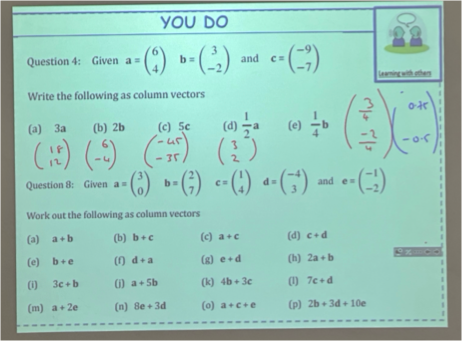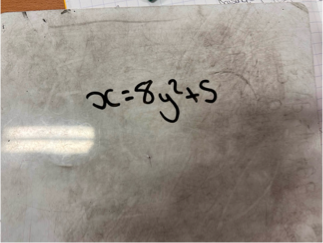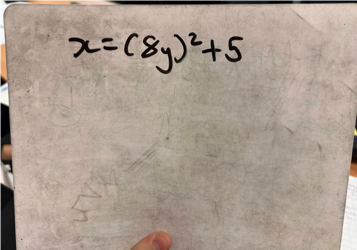Developing a departmental approach to reviewing answers
An example from a school I was supporting
This newsletter is made possible because of Eedi. Check out our brand-new set of diagnostic quizzes, videos, and practice questions for every single maths topic, ready to use in the classroom, and all for free, here.
Overview
This is the third in a series of posts that attempt to shine a light on some of the support work I am fortunate enough to do with the maths departments I visit. Posts will include:
Developing a departmental approach to… reviewing answers (this post)
For more information about my CPD, departmental support, and coaching, please visit here.
Developing a departmental approach to reviewing answers
Most maths lessons involve a period of independent practice, and most of the time that independent practice culminates with the teacher going through the answers. The most common way this plays out is the teacher projects the answers up onto the board, and students are instructed to tick the ones they got right, and then correct the ones they got wrong, usually in green or purple pen.
As I wrote about in The Myth of Copying Things Down and Correcting in green pen does not work, I am not convinced this approach is effective. Students may mark their work incorrectly, copying things down is not the same as learning, and most importantly of all the teacher does not get an accurate sense of who can do what. Even if at the end of the process the teacher asks: Does anybody have any questions?, or Who only made one or two mistakes?, it is all too easy for students to stay quiet, and these misunderstandings and misconceptions remain buried within their books.
This was the exact situation a maths department found itself in. Students’ books looked pretty good:
However, when I challenged colleagues to reflect on how easy it would be for a student to hide a lack of effort or understanding during the reviewing answer process and it not be picked up on, colleagues were open to make a change.
The new process
The Head of Department and I planned out a new approach that would be feasible given the challenges and constraints of the department. It looked like this:
Students do their independent practice in their books as usual
When it is time to go through the answers, the teacher would pick out a critical question. This could be a question they identified beforehand that students might struggle with, or contains a twist, or introduces a new idea. Alternatively, it could be a question that they have noticed a few students having difficulty with when circulating the room during the practice.
The teacher asks students to copy their final answer, without working out, onto their mini-whiteboards, hover the boards face down to indicate they are ready, and show the teacher in 3, 2, 1…
The teacher now has an accurate picture of every student’s effort and understanding for that question. They can then respond accordingly using the approach shared towards the end of the post on the Do Now - in essence, confirm and move on if understanding is secure, model and recheck for understanding with a follow-up question if the boards suggest understanding is not where it needs to be.
They then repeat this process for one or two other critical questions.
Finally, they project the full set of answers on the board for students to self-assess as usual.
If we had unlimited lesson time, we would of course want to see the responses of all students for every question. But I feel this approach at least gives us some valuable data about all students’ understanding without taking over the entire lesson.
What does this look like in practice?
I was fortunate to see this in action the very next day of my visit. The teacher had given his Year 10 class the following set of questions to work through independently:
Whilst circulating, the teacher noticed that some students had different answers for Question 4. So, when it was time to go through the answers, the teacher chose Question 4 as his critical question. He asked students to copy their final answer nice and big on their mini-whiteboards and show his when directed. Most of the boards contained one of the following two answers:
The teacher wrote these answers up on the board, along with another answer that a few students had:
The teacher then asked the students to discuss in pairs these answers. The prompt was super clear:
Tell your partner which you think is the correct answer and why. Listen to their answer and explanation. If your answers are different, who is correct? If your answers are the same, where do the other answers come from?
The teacher then modelled the correct answer, and set the students a follow-up question to complete on their mini-whiteboards:
The students nailed this, and so the teacher moved on, projecting up the answers to the rest of the questions.
How does this compare to your process of reviewing answers? What do you like, and what don’t you like?
How does this compare in terms of the level of direction in your department?
Let me know in the comments below!
🏃🏻♂️ Before you go, have you…🏃🏻♂️
… checked out our incredible, brand-new, free resources from Eedi?
… read my latest Tips for Teachers newsletter about playing the “Does that make sense?” game?
… listened to my most recent podcast about critical evidence during CPD, the Derring Effect and more?
… considered booking some CPD, coaching, or maths departmental support?
… read my Tips for Teachers book?
Thanks so much for reading and have a great week!
Craig








Love this series of articles. Thanks Craig.
While circulating, when we see a common error in a few books we want to address it. You could get bogged down with 1-2-1 support for a few students but potentially miss others and there's an opportunity cost to doing this as other students who have understood the process are left waiting. I saw this happen while observing a trainee teacher recently. Several students were struggling with the same question. The trainee spent several minutes with each student in turn. I watched as students one by one finished the set of questions and were left waiting.
By using this MWB approach, you can gleen how prevalent an error is without having to scrutinise each and every book and you can intervene on a whole class level.
I'd perhaps query the strategy of students discussing the different answers at this point. Might it be better to narrate the correct process of rearranging and then give a follow up question to practice before inviting students to discuss? It depends on how well schema is in place as to how effective this type of discussion is: and if mistakes are being made still, perhaps the schema are not embedded enough yet for purposeful discussion.